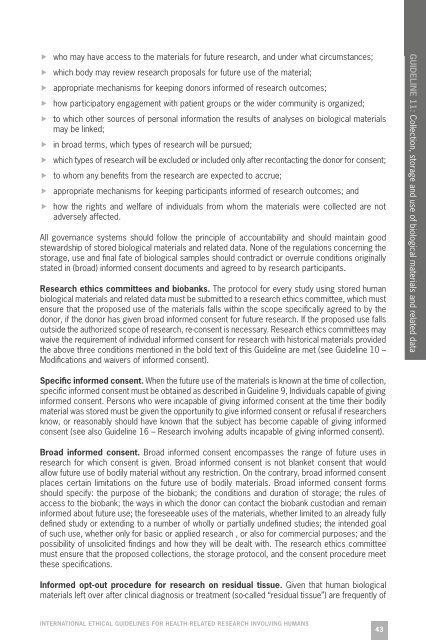International Ethical Guidelines for Health-related Research Involving Humans
WEB-CIOMS-EthicalGuidelines
WEB-CIOMS-EthicalGuidelines
Create successful ePaper yourself
Turn your PDF publications into a flip-book with our unique Google optimized e-Paper software.
ff<br />
who may have access to the materials <strong>for</strong> future research, and under what circumstances;<br />
ff<br />
which body may review research proposals <strong>for</strong> future use of the material;<br />
ff<br />
appropriate mechanisms <strong>for</strong> keeping donors in<strong>for</strong>med of research outcomes;<br />
ff<br />
how participatory engagement with patient groups or the wider community is organized;<br />
ff<br />
to which other sources of personal in<strong>for</strong>mation the results of analyses on biological materials<br />
may be linked;<br />
ff<br />
in broad terms, which types of research will be pursued;<br />
ff<br />
which types of research will be excluded or included only after recontacting the donor <strong>for</strong> consent;<br />
ff<br />
to whom any benefits from the research are expected to accrue;<br />
ff<br />
appropriate mechanisms <strong>for</strong> keeping participants in<strong>for</strong>med of research outcomes; and<br />
ff<br />
how the rights and welfare of individuals from whom the materials were collected are not<br />
adversely affected.<br />
All governance systems should follow the principle of accountability and should maintain good<br />
stewardship of stored biological materials and <strong>related</strong> data. None of the regulations concerning the<br />
storage, use and final fate of biological samples should contradict or overrule conditions originally<br />
stated in (broad) in<strong>for</strong>med consent documents and agreed to by research participants.<br />
<strong>Research</strong> ethics committees and biobanks. The protocol <strong>for</strong> every study using stored human<br />
biological materials and <strong>related</strong> data must be submitted to a research ethics committee, which must<br />
ensure that the proposed use of the materials falls within the scope specifically agreed to by the<br />
donor, if the donor has given broad in<strong>for</strong>med consent <strong>for</strong> future research. If the proposed use falls<br />
outside the authorized scope of research, re-consent is necessary. <strong>Research</strong> ethics committees may<br />
waive the requirement of individual in<strong>for</strong>med consent <strong>for</strong> research with historical materials provided<br />
the above three conditions mentioned in the bold text of this Guideline are met (see Guideline 10 –<br />
Modifications and waivers of in<strong>for</strong>med consent).<br />
Guideline 11: Collection, storage and use of biological materials and <strong>related</strong> data<br />
Specific in<strong>for</strong>med consent. When the future use of the materials is known at the time of collection,<br />
specific in<strong>for</strong>med consent must be obtained as described in Guideline 9, Individuals capable of giving<br />
in<strong>for</strong>med consent. Persons who were incapable of giving in<strong>for</strong>med consent at the time their bodily<br />
material was stored must be given the opportunity to give in<strong>for</strong>med consent or refusal if researchers<br />
know, or reasonably should have known that the subject has become capable of giving in<strong>for</strong>med<br />
consent (see also Guideline 16 – <strong>Research</strong> involving adults incapable of giving in<strong>for</strong>med consent).<br />
Broad in<strong>for</strong>med consent. Broad in<strong>for</strong>med consent encompasses the range of future uses in<br />
research <strong>for</strong> which consent is given. Broad in<strong>for</strong>med consent is not blanket consent that would<br />
allow future use of bodily material without any restriction. On the contrary, broad in<strong>for</strong>med consent<br />
places certain limitations on the future use of bodily materials. Broad in<strong>for</strong>med consent <strong>for</strong>ms<br />
should specify: the purpose of the biobank; the conditions and duration of storage; the rules of<br />
access to the biobank; the ways in which the donor can contact the biobank custodian and remain<br />
in<strong>for</strong>med about future use; the <strong>for</strong>eseeable uses of the materials, whether limited to an already fully<br />
defined study or extending to a number of wholly or partially undefined studies; the intended goal<br />
of such use, whether only <strong>for</strong> basic or applied research , or also <strong>for</strong> commercial purposes; and the<br />
possibility of unsolicited findings and how they will be dealt with. The research ethics committee<br />
must ensure that the proposed collections, the storage protocol, and the consent procedure meet<br />
these specifications.<br />
In<strong>for</strong>med opt-out procedure <strong>for</strong> research on residual tissue. Given that human biological<br />
materials left over after clinical diagnosis or treatment (so-called “residual tissue”) are frequently of<br />
INTERNATIONAL ETHICAL GUIDELINES FOR HEALTH-RELATED RESEARCH INVOLVING HUMANS<br />
43


